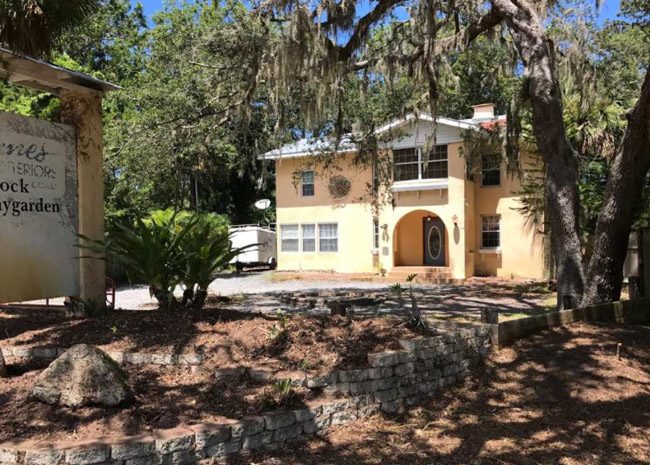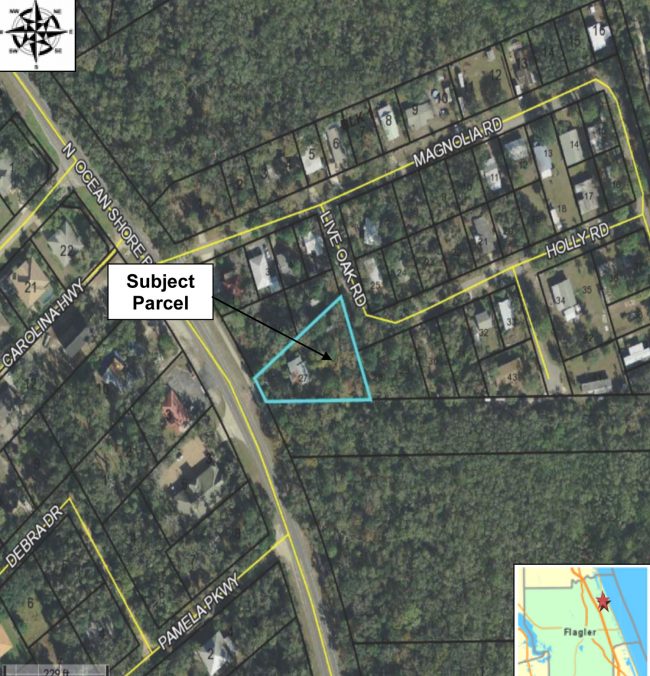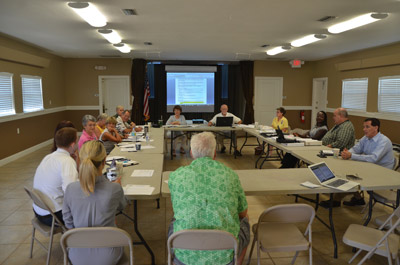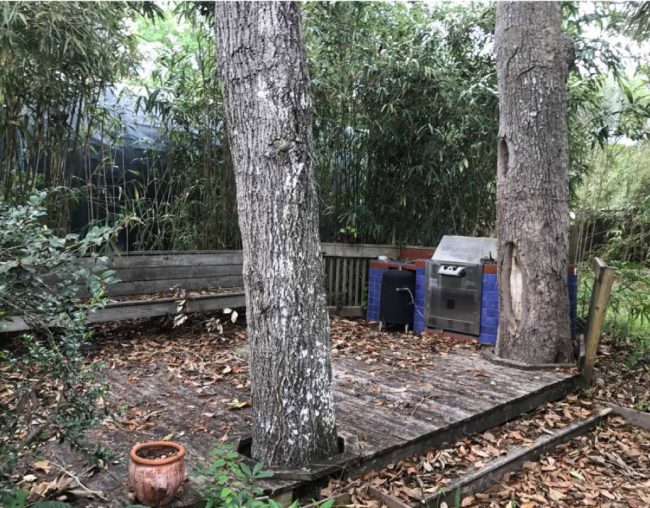
The Flagler County Planning Board approved a new restaurant and microbrewery that will occupy a 59-year-old building, long vacant, on a 25,000 square foot parcel at 5047 North Oceanshore Boulevard, or State Road A1A, in the Hammock. It’ll be the second microbrewery to open in the county after the launch of Moonrise Brewing at European Village late last year.
But the Planning Board’s approval—which doesn’t need ratification by the Flagler County Commission—was carried out without an opinion from the Scenic A1A Pride Committee, an advisory panel that signs off or at least weighs in on development plans along A1A. Nor was such an opinion part of the planning department’s process, even though those opinions, according to county documents, appear to be required, not optional.
And Planning Board members were misled—unintentionally, it appears—when they asked county administration staffers and their own attorney whether A1A’s input was required, as some board members thought it was.
“Having sat on this board for six or seven years now,” Planning Board member Laureen Kornel said, “almost all the applications that have come through have had a letter which Scenic A1A Pride—I actually see them as part of the process, and not an obstacle or an adverse group whatsoever. The projects go through. They’re just a part of the process.” Kornel would prove to be the only dissenter in the pair of 6-1 votes that approved the restaurant project.
Earlier, Kornel had asked Adam Mengel, the county’s planning director, whether “it is a code requirement that they [meaning the A1A committee] review certain applications,” and whether “special exception one of those applications?”
“It is,” Mengel said. In his opening remarks, he’d noted to the board: “If you feel that you need some additional detail, then maybe I’d opt instead for tabling and waiting for some review by A1A. I don’t believe that’s necessary at this time though.”
Other Planning Board members were also concerned about the absence of an opinion by the A1A committee.

The remarkable exchange between Langello and Mengle went as follows:
“You said something to that, that A1A Pride must look at this? Was that what you said earlier? Or was it that they may look at this?” Langello asked.
“They typically review special exceptions–,” Mengel said, before Langello cut him off.
“That wasn’t my question. Is it a must, or is it a may, in effect?” Langello asked.
“I don’t think I can dictate what Scenic A1A can and can’t do,” Mengel said, again not answering the question.
“For our process, must we hear a comment back from Scenic A1A to properly review the application?” Langello pressed again.
The County Commission voted 4-1 in 2005 to Give Scenic A1A a “mandatory” role in reviewing development plans.
“I’m still going to dance,” Mengel said. “I know other people are going to be around me saying oh, no, no. I cannot dictate what Scenic A1A does or does not provide to us. So if they did review, and they did not—I’ll say that: they did not review the special exception application. Should they have? Yes. Did they review the future land use and the rezoning? Yes. Has the application substantially changed from that? No, the application type has changed, but your site plan has stayed the same, the operation that they proposed stayed the same. True, they have not reviewed nine criteria special exceptions in the context of Scenic A1A criteria, but that’s not their prerogative. They don’t provide a recommendation and review on our criteria, that’s your job. So, sorry to be so abrupt on it, but I cannot answer for them, and I cannot dictate that they have to provide comments to you. They can review something and then choose not to provide a comment, that’s their prerogative. But should they have reviewed, and should they review applications, including special exceptions, variances, future land use and rezonings, my answer is clearly and quickly yes, they should.”
“And that opportunity was afforded to them?” Langello asked.
“It was not afforded to them because the special exception application was submitted after our December meeting,” Mengel said, “and so because the timing, because of the holidays, they did not have the ability to review this prior to our meeting, the special exception itself.”
The county, of course, had the ability to delay the submission of the application to the planning board until its next meeting: it did not do so, even though the same item had been rejected at the December meeting, and therefore delayed until January, when planning board members had other problems with it.
Still uncomfortable with the explanation, Langello at that point turned to Kate Stengel, the county’s attorney for the planning board. He asked her whether the board was in good standing if it went ahead with a decision on the restaurant without A1A Pride weighing in.

That contradicted Mengel’s earlier assertion that it was a requirement by code, though Mengel was somewhat off the mark, as was Sherman, who said: “They have made several attempts to formalize their role in the planning process, and our board has not chosen to do that.”
In fact, the County Commission had done just that, a few years before Sherman or Mengel started working in Flagler.
The County Commission held a special meeting on April 12, 2005, specifically to discuss and decide the role of the Scenic A1A Pride committee regarding the A1A Corridor Management Plan. The special meeting had been classed at the specific request of the committee to clarify such issues. The commission voted 4-1 to make it “mandatory” that “all development projects to the Scenic A1A Pride Committee for input and review, but that the results must not be mandatory in order for the BCC to approve it.” The BCC is the Board of County Commissioners. As the county attorney at the time explained the motion, the committee would issue an opinion, but the commission would have the final say. The planning director’s understanding was the same, noting that only development projects in the A1A overlay district would be subject to the mandatory provision.
Al Hadeed, then an attorney in private practice, was among the members of the public who addressed the commission. According to the minutes, he explained that “the reason for a mandatory referral was that six months ago staff was encouraging developers to get that input, but now there was a perception that they were inconsequential. The only way to reverse that, at this point in time, was a mandatory referral.”
Asked today whether that decision had since bene reversed, Hadeed, the current county attorney, said: “To my knowledge, there’s been no board action that modifies that determination.”
(Scenic A1A was involved in the reviewing process of a different step of the restaurant application, that one involving a zoning change and the application for variances.)
The issues surrounding the proposed restaurant were a different matter. Brent Burns was appearing before the board because he was applying for a set of special exceptions to existing requirements. Even setting the A1A committee issue aside, the exceptions led to protracted wrangles since December that were complicated, somewhat controversial, and opposed by local residents surrounding the new restaurant, though to a large extent the controversies replayed the sort of scenarios familiar to situations where a new business seeks to get established within a short distance of residences, as this restaurant would be, though not by much: it is to the south of Holly Road, Live Oak Road and Magnolia Road.

“As it stands in its current state this site is unkempt and overgrown,” Melissa Tincher, project engineer with the Alann Engineering Group in Ormond Beach, told the board. “While we’re proposing to lessen our landscape buffer and building setback requirements, we’re doing so in order to give the community a beautiful destination venue to come to. The excess of beautification throughout the site, the improvements of currently run-down structures will yield an overall improvement of aesthetic appeal on the site and hopefully enhance the community for years to come.”
She said the restaurant will primarily have outdoor seating, a total of 40 seats, with “natural plant elements,” waterfalls, natural streams, access through a single access road off of A1A, bike racks, 10 parking spaces, and “any music that will be played will be that which is appropriate for an upscale dining experience, and will be more in the realm of quiet background music, rather than a loud band.” The brewery would brew 100 gallons per week, or three barrels. “Because it’s such a small brewing operation it’s not anticipated that any smell complaints will be aroused by anything that’s going on there,” Tincher said.
Brent Burns, the applicant, also spoke a few times, though his explanations lacked crispness and clarity, as did, to a certain extent, that of the planning department itself, leading the board to circle around several questions down to the number of gallons of beer that may be brewed and how parking will be handled. Board members were concerned about parking, since 10 spaces will clearly not be enough to meet the requirements of the code (a space for each employee in each shift, and one space for each 50 square foot of gross seating area), and that question was never fully resolved other than to compel the applicant to return to the planning board should he arrive at an arrangement with other businesses to enable valet parking. (Burns spoke vaguely about having had discussions with neighboring businesses about parking.) The smell that would emanate from beer production, the music, a perimeter fence and the location of the brewery were all concerns as well.
A half dozen neighboring residents spoke, none favoring the project, though again, that’s not unusual in such situations, though in some cases the opposition seemed sharply ironic.

“I don’t believe we should have manufacturing out there, it’s the Hammock,” a woman who owns a property to the north of the proposed restaurant said. “There’s a status symbol to the address. I don’t see it bringing more value to the Hammock, it’s only going to employ two people at a time, it’s not like it’s going to bring a lot of jobs.” Yet the woman herself was a restaurant employee elsewhere.
Others spoke about the retirees who live in the neighborhood. “We just don’t; want to get into the hustle and bustle of restaurants and that that kind of thing,” one said.
Burns reassured them. “There’s almost no smell that’s going to come out of this place,” he said. “I don’t want a noisy place. We’re talking about maybe somebody walking around the tables with a mandolin, or someone playing the guitar, or something to enhance the meal. This isn’t a rock-n-roll thing where we’re going to have a huge band out there and getting everybody up to dance.” He added: “We’ve agreed to almost everything that everyone has asked us to do and we’re going to be held accountable for it, so this is not one of those things where, OK, you get approved, and then you just do whatever you want. We’ve tried to comply with every possible thing to make this the kind of place that everybody would like to come to. I’d be more worried about the piece of property that’s next to me that has a trailer that’s falling apart and it looks like a junk yard back there, if you’re worried about the values and talking about that kind of property.”
But it wasn’t just residents who had issues.
“Is staff comfortable with what’s being provided for parking?” Kornel asked Mengel, the planning director.
“You could probably tell from how we were dancing about it before, we’ve got some concerns, we’ve got some reservations with this,” Mengel said.
Music was limited to no later than 9 p.m., though it was never clear whether only acoustic instruments would be allowed, as opposed to amplified music as well.
Timothy Conner, a planning board member, pushed back against residents’ concerns most succinctly.
“I don’t mean my comment to be an affront to any of you residents attending here tonight,” Conner told them. “I understand your concerns, and I appreciate where you’re coming from. One of the things that makes the Hammock special is that it’s finite space. We’re hemmed in by the Atlantic Ocean on one side and the Intracoastal on the other. It’s a special place, and I understand that. But the reality is that it’s a central corridor that goes down the Hammock, and it’s called A1A, and almost virtually all the front footage ion A1A is zoned RC [residential-commercial], or commercial. It was designed that way, and almost all the footage behind the front footage, almost all the lots whether you go east to the Atlantic Ocean or whether you go west to the Intracoastal, is residential. Which means that by design, commercial down A1A butts up against residential behind it, and it’s designed that way. Can’t be any other way because that’s the way it is. And so there isn’t a place in the Hammock where anyone can do a commercial development that’s not going to impact somebody’s neighborhood behind it, and unfortunately in this situation, it’s y’all’s neighborhood that got impacted, or that potentially will be impacted.”
He then cautioned opponents of the project about the alternative. “If we say no to small-scale development, if we say no to little guys trying to do creative things in the Hammock, what are we left with? I think that we’re left with is the guys that come behind the little guys, reading the handwriting on the wall, and realizing that what they have to do is put a lot of parcels together and do a big development instead of a little development, and then you’ve got more stuff that looks like the Publix shopping center or the fire station or those sorts of things, and that’s what we’re trying not to do in the Hammock. So I think we should encourage creative thinking in the development of commercial in the Hammock or we’re going to get what we’ve asked for, which is something different than that.”
Michael Boyd, another planning board member, spoke in terms of the balance between property rights and the quality of life of existing residents, but then seemed to almost ridiculer the notion of a still-scenic A1A. “I would suggest that if you think A1A is scenic now, you should have seen it 30 or 40 or 50 years ago before all these people moved into it and started building along A1A,” Boyd said. “It was truly scenic back then.”
The Scenic A1A committee’s involvement is intended to help preserve what’s left of its namesake, but Boyd did not address the absence of an input from the committee.
![]()
The Background and Staff Report on the Restaurant Proposal
Click to access hammock-restaurant-planning-board.pdf





























DRedder says
Seems to me they not only didn’t violation any rule but that the A1A is a bunch of fat cat bureaucracy not in my neighborhood bunch without any authorization. As if we need more government restrictions
anon says
Dredder, ok good. So they can build anything next to your house, then, correct? No restrictions means just that. Be careful what you wish for.
anon says
So this commercial building has been sitting there empty for many years, and now a company wants to come in and spruce it up and provide a restaurant/microbrewery, jobs, etc. and the neighbors are complaining??? And what’s with having only 10 parking spaces but room for 40 seats?
Really says
Too much red tape for a brew haus. No wonder co.s dont come here or stay
Justso says
Let the business get going. Nothing like fake red tape, so we get and old building cleaned up, a few new jobs, maybe some non greasy food for a change.
I would like to know this ” A1A Pride Committee”, where is their action on the drug users hanging out across from Armand Beach Dr back in the woods in tents, or some of the dirty sandlot parting lots, or some of the eye sore derelict vehicles along A1A across from Armand Beach Dr. You want pride, clean that up first and stop worrying about some job creating business.
No parking says
We own property to the North, no parking will be allowed on our property or use for drain field.which was asked by restaurant. We declined